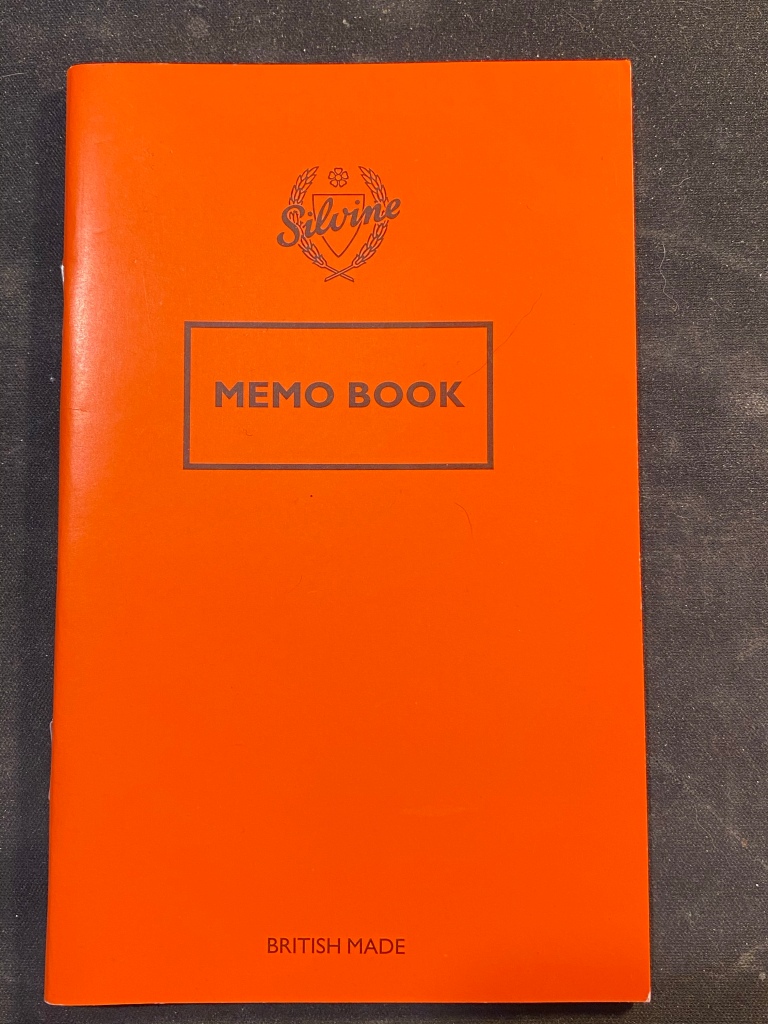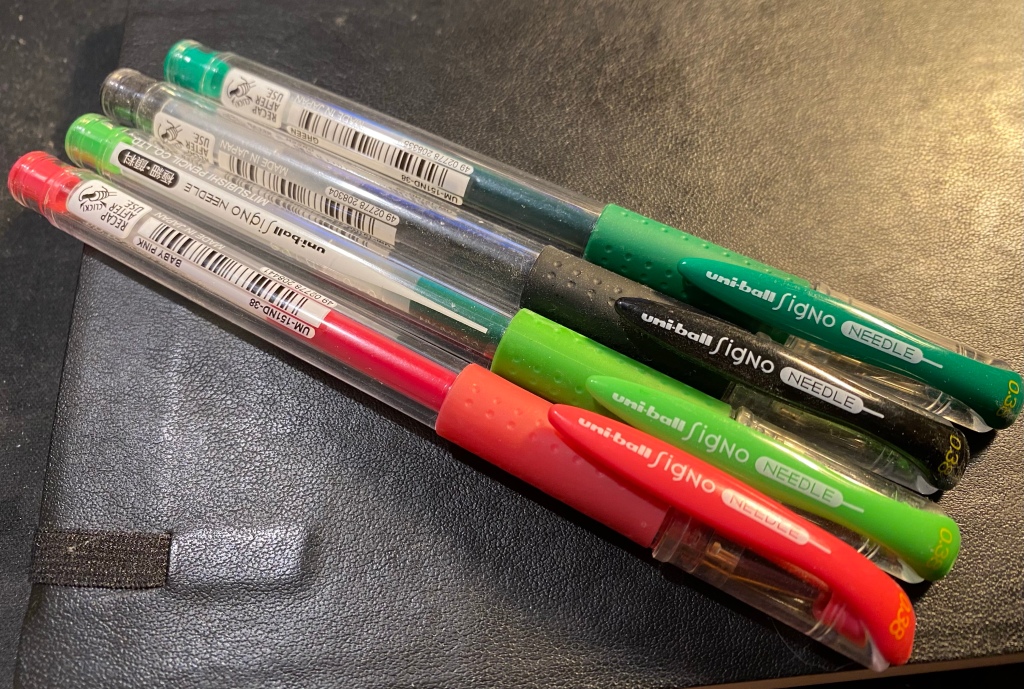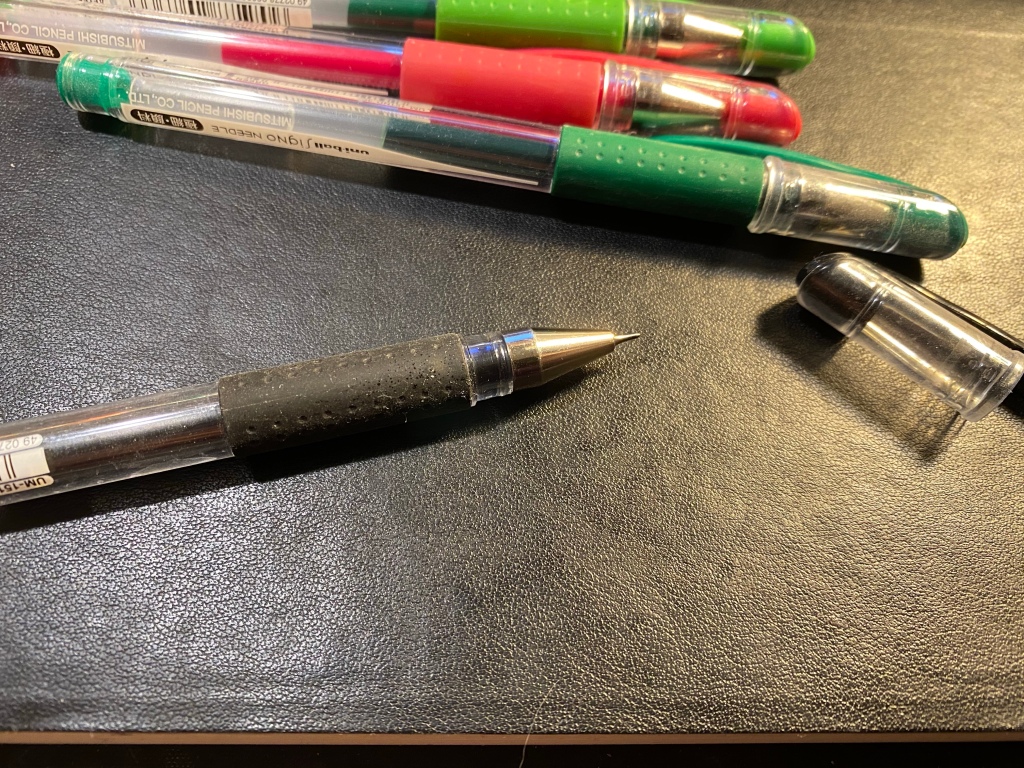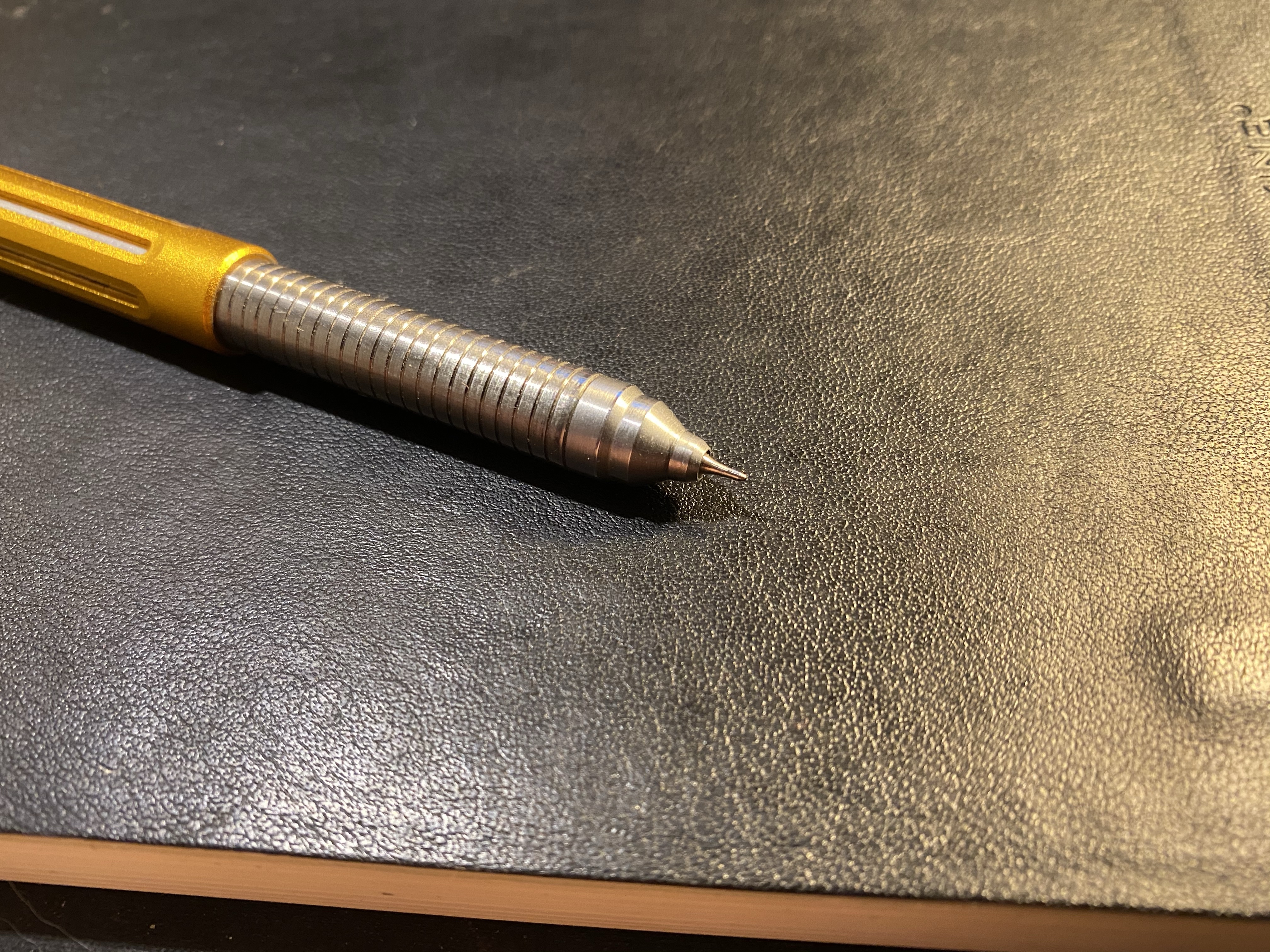Rob Roy Track, New Zealand

First “serious” watercolour in a while, and another test for my new palette.
A blog about writing, sketching, running and other things

First “serious” watercolour in a while, and another test for my new palette.

Another page out of my sketchbook. I’ve had the DDC Rumpl blanket for over two months and it’s become a house favourite. The only thing I regret is buying only one.
For the first time ever I managed to write a Pilot High-Tech-C (also known as G-Tech-C) refill dry. The tip didn’t bend to death because someone breathed on it wrong, the refill didn’t have strange bubbles that meant that it just decided not to write any more, and the ball in the tip didn’t break off (thus rendering the pen into a particularly terrible rapidograph). This feels like an achievement and I am going to celebrate — by picking up a brand new High-Tech-C of course.




Catching up on some more sketchbook pages from my Sketchbook Design course as I’m working on giving my palette the largest overhaul it’s had since I started painting with watercolours. This page was inspired by the final box I got from the Tel Aviv muncipality’s “The Box” project, created to support local businesses during the lockdown.

As I’ve recently overhauled my sketching tools and have grown to like my new setup, I’ve decided to document my current sketching kit, as a reference to myself and others.

First up are my pen and pencil cases, the Nock Co Sinclair and Tallulah. I used to use the Sinclair as my main sketching case because:

The Sinclair is no longer my main case and I now use it to store a more extensive selection of sketching tools (mostly Faber Castell Pitt brush pens). The reason is that it can hold so many pens that I was tempted to fill it to the brim and bring all those pens with me. As I decided that to gain speed I needed to pair down my sketching tools and expand my watercolour palette, I replaced the Sinclair with the much slimmer Tallulah.

The Tallulah is marketed as a two pen case. Oh, Brad. I have four Staedtler Fineliners, a Uni-ball Signo Broad white gel ink pen, a woodcased pencil, three (!) Sailor Fude fountain pens and a waterbrush. If the Tallulah had two zippers instead of one I could have closed the case. As it is, I keep it open and propped up in my sketching bag, as sort of a pen organizer. If I need the Tallulah to close, I can pare down my pens to one or two Sailor Fude pens, lose the waterbrush (if I keep two Sailor Fude’s in my kit), and replace the woodcased pencil with a mechanical one, or lose the pencil entirely as I generally work directly in pen and watercolour these days.

The Tallulah is so slim and light that it really works with my low profile sketch kit. It’s actually the anchor around which I built my new kit, with the other two being the Stillman and Birn Alpha sketchbook that I’m using, and my Schmincke watercolour tin.
If you are an artist looking for a storage solution for your pens and pencils, I highly recommend giving the Nock Co Sinclair and Tallulah a try. They are handsome workhorses that can take a beating (especially the zippers) and can hold many more pens than you would normally imagine.
I bought this notebook in 2019, when I was last in London. Silvine is a well known UK notebook brand, and ever since I read about them in Roald Dahl’s work I have been looking to try them out.

The Silvine Memo Book is a 159x95mm feint ruled staple bound notebook with zero frills. The cover is made of construction paper, thinner than the standard Field Notes one. The corners aren’t rounded, and there’s no printing on the inside of the cover. The front cover is a big believer in the “says what it does on the tin” school of thought: it’s a British made memo book by Silvine.

The back cover has an ugly barcode and ref printed on it, and it really would have looked better with that barcode printed on the inside. Then again, this notebook is not about looks.

The grey ruling is 7mm wide, with margins left on the top and bottom of the page. It’s a bit wide for the format, but I’m guessing that they took their standard ruling and applied it indiscriminately to all their notebooks. The paper is where the Silvine Memo Book surprisingly shines.

The paper is smooth and coated, which means long drying times (though still shorter than Rhodia or Moleskine paper), but it’s also fountain pen friendly. The ink doesn’t feather or spread, and while there is some ghosting, unless you use stub nibs with dark inks the other side of the paper will still be usable. Very juicy nibs cause a small amount of bleed through, and the Sharpie, as usual is a mess, but otherwise Silvine have created a paper that can handle pretty well everything you throw at it.

The format of this notebook means that its place is on a desk, where you can use it to jot down a quick note with whatever is lying around. It’s not built for pocket carry (in terms of size or construction), and I would have liked the ruling to be 6mm or even 5 mm at this size, but as it is I don’t regret buying the Silvine Memo Book, if only for nostalgic value. It reminds me of Dahl’s short stories, and I like that it’s doing its own thing and not trying to be a Field Notes clone. If you’re in the UK, I’d have one or two of these lying around, just for the paper inside.

My first Urban Sketchers Sketchcrawl of the year (there was one earlier, in March, but my mom was hospitalized, so I couldn’t make it) to the brand new Park HaMesila in the beautiful Neve Zedek neighbourhood. A dump and parking lot have been transformed into a park that will lead all the way to the Tachana complex once it’s complete. At the moment it offers a very little shade and not much greenery, but you can see the potential, and you can definitely see how much people are loving it.

The park follows the old Turkish railroad (which went from Jaffa to Jerusalem and was notoriously slow), and though I didn’t draw them because things were starting to get too busy in my sketch, the path has old rail lines embedded into it, which is a lovely touch.

I then drew part of Suzanne Dellal’s Center of Dance (it’s the Batsheva’s Dance Company’s home, and in Hebew is generally pronounced Suzanne Dallal).

A spread summarizing my day and a bit more of the neighbourhood, created at home (unlike the first two) from pictures. I traced the map from a navigation map that I got from a local navigation race that happened to take place in the area, and had fun with some design elements that I learned in the Sketchbook Design course that I took.
I used my new palette and a brand new Stillman and Birn Alpha and I quite like the freedom that its lightweight paper encourages.
I am a huge fan of the Uni-ball Signo line, and the Signo RT 0.5 is my favourite gel pen body and my favourite gel ink refill (UMR-85N). In second place is the Uni-ball Signo DX (UMR-1 refill) and its less common brother: the Uni-ball Signo Needle, which is basically a Signo DX with a needle tip instead of a cone tip.

Like the Uni-ball Signo DX the Uni-ball Signo Needle isn’t as commonly found in the wild of stationery stores as the Pilot G2 or Pilot Hi-Tech-C. It does, however, come in a wide variety of colours, and unlike the Pilot G2 doesn’t blob and smear like crazy. It also has a needle tip that doesn’t wither the moment you look at it, unlike the Pilot Hi-Tech-C. It’s a workhorse needle tip gel pen with an excellent refill that doesn’t dry out even after spending years on your desk, and allows you to use it without worrying about babying its fragile needle tip.

I love the Pilot Hi-Tec-C but I’m well aware that I have thrown more of them away than I have been able to use (the tip bends, the ink dries up and the pen no longer writes, there are “bubbles” in the refills of the even more delicate multi-pen variants of this pen). I’ve yet to have thrown a Uni-ball Signo pen away, needle point pens included. The magic happens in the tip design, which isn’t a two part deal like in the Hi-Tech-C but rather is a DX tip that has been shaped into a needle point, as if someone had taken it between two fingers and squeezed it to form a needle tip. The result is a tip that is stronger with no weak points that are prone to bending.

You can see the difference between the Signo Needle tip on the top, and Signo DX tip in my Spoke pen on the bottom. It’s basically the same tip just tapered more acutely.

In terms of refills, the Signo Needle uses a UMR-1ND refill, which is the same as the Signo DX’s UMR-1 refill just with a different tip attached. This means that there are very few machined pens on the market that will fit the UMR-1ND refill because of the way the front of the refill is designed. However…

The Signo Needle refill does fit the Spoke pen! This is a fun bonus of them having the same refill design as the DX (minus the tip). So now not only can you have a reliable needle point gel ink pen with a variety of refills, it will also fit one of the best machined pens on the market (at least in my opinion).

I will point out that there is a tiny gap between the pen tip and the grip if you do use a UMR-1ND refill in the Spoke pen, however, the refill doesn’t wiggle in the pen and the gap doesn’t extend into the pen body – it’s just an aesthetic thing.

Here’s a writing sample with the Signo Needle 0.38. As you can see the lines are crisp and consistent even though I’ve had some of these pens lying around my desk for years. They are a tiny bit wider than the Hi-Tech-C 0.38 lines (just as the Signo DX 0.38 lines are wider than the Hi-Tech-C but thinner than the Pilot G2 0.38).

If you’re looking for a needle tip gel ink pen and are tired of throwing out broken Hi-Tech-Cs (or don’t like their somewhat spartan pen body), give the Signo Needle 0.38 a chance. It may be slightly more expensive than a Hi-Tech-C, but it will ultimately turn out to be cheaper because you’ll have a pen that you can actually use from start to finish.

This is the first time that I’ve used my new watercolour palette and I’m still figuring stuff out. I’m also using an 8’’x10’’ Stillman and Birn Alpha which is a large format that I’m still getting used to and isn’t the best for smooth washes. I’m embracing the patchiness here and letting the paint do its thing. More importantly, despite temptation I’m not making any adjustments to the new palette now, as I need more time with it.
Also, the Sailor Fude 55 degrees fountain pen is magic. I used one here with Noodler’s Lexington Grey.